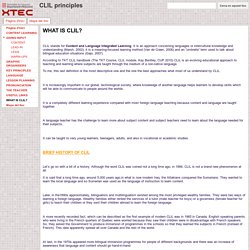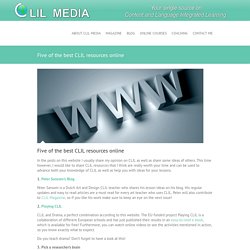

IRENA
LONDON LANDMARKS. WHAT IS CLIL? - CLIL principles. CLIL stands for Content and Language Integrated Learning.

It is an approach concerning languages or intercultural knowledge and understanding (Marsh, 2002); it is a meaning-focused learning method (Van de Craen, 2006) and an “umbrella” term used to talk about bilingual education situations (Gajo, 2007). According to TKT CLIL handbook (The TKT Course, CLIL module, Kay Bentley, CUP 2010) CLIL is an evolving educational approach to teaching and learning where subjects are taught through the medium of a non-native language.
To me, this last definition is the most descriptive one and the one the best approaches what most of us understand by CLIL. It is increasingly important in our global, technological society, where knowledge of another language helps learners to develop skills which will be able to communicate to people around the worlds. History of CLIL. Defining CLIL. There was a lot of discussion about what exactly CLIL is, whether it is different from other approaches such as EMI (English as a Medium of Instruction) or CBI (Content-based Instruction) or CALLA (Cognitive Academic Language Learning Approach).

One colleague sees CLIL as a special form of TEFL, with the main emphasis being on the language. Another colleagues is equally sure that 'CLIL is of course content-based instruction, which is an area loaded with confusing and overlapping terminology (CLIL, SIOP, ESP, EAP, Sheltered, task-based, immersion, etc.)'. A useful distinction is drawn between 'cross-curricular' language teaching - teaching normal academic subjects in English to non native speakers - and other types of content based teaching where the content is given priority to the linguistic aims. One colleague asks if the time has come to begin labelling parts of the CLIL continuum in order to define more precisely what goes on in the classroom. A CLIL Guide 5 activities for every CLIL teacher. Checklist how ClIL are you & Scoring. How to design a great CLIL activity. A lot has been written about CLIL activities.

The very good book “CLIL Activities” by Liz Dale and Rosie Tanner, but also “CLIL Skills” and “The TKT Course CLIL Module” are very interesting reads if you want to find inspiration for your own CLIL activity. However, I still hear teachers say they think CLIL is a lot of work. They say they don’t want to ‘change their entire lesson’. They ‘don’t have time‘. I think this is nonsense. CLIL: What is CLIL? Five of the best CLIL resources online - CLIL Media. In the posts on this website I usually share my opinion on CLIL as well as share some ideas of others.

This time however, I would like to share CLIL resources that I think are really worth your time and can be used to advance both your knowledge of CLIL as well as help you with ideas for your lessons. 1. Peter Sansom’s Blog Peter Sansom is a Dutch Art and Design CLIL teacher who shares his lesson ideas on his blog. His regular updates and easy to read articles are a must read for every art teacher who uses CLIL. 2. CLIL and Drama, a perfect combination according to this website. Do you teach drama? 3. Short Stories. Food & drink. Kids. "grammatikbok" online. Speaking ESL.
Language. Grammar. Describing appearanes. Modal Verbs. "grammatikbok" online. Dave's ESL Cafe. English Grammar Games - Juegos para aprender inglés gratis. English grammar: A complete guide. Do you have a question about the correct usage of the semi-colon or how to place relative adverbs in a sentence?

If so, you've come to the right place! The edufind.com English grammar guide is a complete reference on the rules of English usage. Every grammatical rule is explained in clear, simple language with several examples and, when necessary, counter-examples. The grammatical rules covered by this guide are categorized by part of speech. You will find the categories listed below. Comparisons Conditional Future Gerund and Present Participle Infinitive Passive Voice Past Present Functions and classes of determiners Articles Quantifiers Distributives. English grammar and vocabulary exercises, with answers, for ESL learners.
Grammar,Vocabulary Worksheets,Handouts,Tests,Puzzles. English4u. English exercises - grammar exercises - learn English online. Free English Grammar Exercises and Quizzes. Tenses. English Grammar Exercises. English Pool of Exercises on Tenses.
Grammar Bytes! Grammar Instruction with Attitude. TO LEARN ENGLISH all tenses. Advanced English lessons. Verbs - Likes. Level 200 Grammar Topics. Grammar. English Prepositions. So what are prepositions?

A preposition is a word which is used before a noun to show its connection to another word in the sentence. For example: The dog rests on the armchair. (The word "on" is used before "the armchair". We understand that the dog is on the armchair. The name "preposition" (pre + position) means "put before". Here are some more examples: She stands by the tree. The cat leans against the garbage can.
The sign is under the car. The rocket went through the heart. They flew into the snow. She is reading to her babies. He is climbing up that mountain. A preposition can come before a pronoun as well. For example: